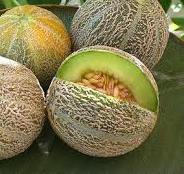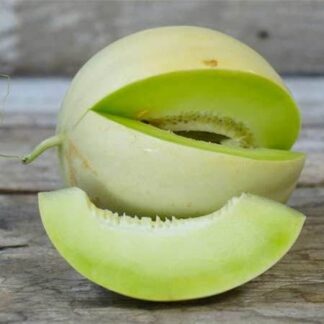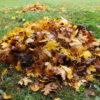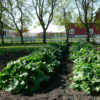Description
Rocky Ford Cantaloupe (A.K.A. Eden Gem or Rocky Ford Green Flesh)
25 Seeds per pack
Days to Maturity: 80–95 days
Sun Requirements: Full Sun
Botanical Name: (Cucumis melo)
Rocky Ford is a classic heirloom cantaloupe with a rich history rooted in American agriculture. Originating in 1881 in Rocky Ford, Colorado, this variety descends from the famed “Netted Gem” melon first introduced by George Washington. The region’s unique combination of hot days, cool nights, and mineral-rich soil produced cantaloupes with extraordinary sweetness, setting the standard for melons across the country.
Fruits weigh between 2 and 3 pounds and average 5.5″ long by 5″ across. The rind is dark green and covered in thick netting. Inside, the flesh is bright green and juicy. Compact vines spread 3 to 6 feet and grow 12 to 18 inches tall, making them manageable for garden beds and larger containers.
This green-fleshed variety is prized for its rich, spicy-sweet flavor and refreshing, creamy texture—perfect for slicing fresh or enjoying chilled on a hot day.
Rocky Ford is a productive producer with excellent resistance to rust and is known for being a good shipper—qualities that made it a favorite in both farmers markets and vegetable stands. A garden favorite for over a century, Rocky Ford is a must-have for any garden!
Disease resistance: Rust
Planting Instructions for Rocky Ford Cantaloupe Seeds
When to Plant:
Direct sow Rocky Ford Melon seeds outdoors 1 to 2 weeks after your last frost date, once the soil consistently reaches 70°F (21°C) or warmer. For shorter seasons or cooler regions, start seeds indoors 4 to 6 weeks before last frost, using peat pots or soil blocks to avoid root disturbance. Transplant outdoors after hardening off and when both soil and air temperatures are consistently warm and the danger of frost is past.
Where to Plant:
Choose a site in full sun that receives at least 8 hours of direct sunlight daily. Rocky Ford Melons thrive in fertile, well-drained soil with a pH of 6.0–7.0. Raised beds or south-facing slopes are ideal. Incorporate 2–3 inches of compost before planting. Avoid planting in areas that recently grew other melons, cucumbers, squash, or pumpkins.
How to Sow:
Sow seeds ½” to 1″ deep. If planting in rows, space seeds or transplants 18–36″ apart in rows 5–6′ apart. For hills, sow 3–4 seeds per hill and thin to the strongest 1–2 plants.
Watering:
Keep soil consistently moist through germination. Once vines are established, provide 1–2 inches of water per week. Water deeply and less frequently to encourage deep rooting. Reduce watering slightly once fruit begins to ripen to improve sweetness and avoid splitting. Avoid overhead watering to reduce the risk of mildew.
Fertilization:
Mix compost into the planting site before sowing. Additional fertilizer is typically not needed unless soil is poor. If desired, side-dress with compost tea, fish emulsion, or a balanced organic fertilizer once vines begin to spread and again when the first small fruits begin to form.
Mulching:
Once your seedlings are growing well, add mulch around the plants. Use black plastic if your goal is to warm the soil. Warmer soil helps seeds sprout faster and encourages early root and vine growth, which is especially helpful in cooler climates or early in the season. If you’re mainly trying to hold in moisture and stop weeds, straw or shredded leaves are good options, but they won’t help the soil warm up as much. Mulching also keeps the fruits clean by lifting them off the dirt and helps stop mud from splashing onto them when it rains.
Training & Pruning:
Vines can be allowed to sprawl or trained vertically. For vertical growth, support fruit with cloth slings. If desired, lightly prune some of the small side branches that grow off the main vine to help air move through the plant and let it focus energy on growing better-quality fruits. Avoid over-pruning, which can reduce flower production and sugar development.
Pollination:
Rocky Ford Melons produce both male and female flowers. Bees and other pollinators are essential for fruit set. Encourage pollination by planting pollinator-friendly flowers and herbs nearby. Good choices include borage, dill, sunflowers, marigolds, and oregano allowed to flower. These help attract bees and other insects that will visit your Rocky Ford Melon blooms. In low-pollinator areas, hand pollinate by transferring pollen from male to female blooms using a small paintbrush.
Common Pests & Diseases:
- Pests: Watch for aphids, cucumber beetles (vector for bacterial wilt), squash bugs, and vine borers. Use row covers until flowering, hand-pick pests, or apply insecticidal soap in the early morning or evening.
- Diseases: Powdery mildew, downy mildew, and leaf blights can occur. Improve air circulation, avoid overhead watering, and space plants adequately. Treat outbreaks with organic fungicides or DIY sprays (e.g., baking soda solution).
Harvesting:
Rocky Ford Melons are ready to harvest when the rind becomes tan beneath the heavy netting and the fruit slips easily from the vine. A sweet, musky fragrance at the blossom end and slight softness when gently pressed are other signs of peak ripeness.
Storage:
Store whole Rocky Ford Melons at room temperature for a few days or refrigerate for up to 1 week. Once cut, store in a sealed container in the refrigerator and consume within 2 to 3 days. Wash the rind before slicing to avoid contamination of the flesh.
Seed Saving:
Saving Rocky Ford Melon seeds is an enjoyable and economical way to preserve this historic heirloom. Rocky Ford Melons are insect-pollinated and cross readily with other melon types, so avoid growing multiple melon varieties within ½ mile of one another.
Let the melons ripen fully on the vine. Once picked, cut them open the long way and scoop out the seeds into a jar. Add room temperature (not hot) water and let the mixture sit for 2 to 4 days, stirring it once each day to help the seeds separate. Good seeds will sink, while pulp and non-viable seeds float. Pour off the debris, rinse the good seeds thoroughly, and spread them out on a paper towel or mesh screen to dry for several days in a well-ventilated area.
Once your seeds are fully dry, you can store them in a labeled container. For longer storage, you can keep the container right in the freezer. Freezing helps protect seeds from moisture, pests, and temperature swings, especially over many months. For a quick and easy option, use our seed-saving envelopes. They’re simple to use, pre-labeled, and include spaces to write the variety, date, and any notes you want to remember. They help keep your seeds neat, labeled, and easy to find when you’re ready to plant next season. When stored properly, Rocky Ford Melon seeds can last 3–5 years.
FAQ:
What is the historical or notable background of Rocky Ford Cantaloupe?
Rocky Ford Cantaloupe traces its roots to the 1880s in Rocky Ford, Colorado. It descends from the “Netted Gem” melon introduced by George Washington and gained national recognition for its sweetness, thanks to the region's ideal growing conditions of hot days, cool nights, and mineral-rich soil.
How would you describe the flavor of Rocky Ford Cantaloupe?
Rocky Ford Cantaloupe is celebrated for its rich, spicy-sweet flavor and creamy, refreshing texture, making it a favorite for fresh eating or enjoying chilled on hot summer days.
What does Rocky Ford Cantaloupe look like, and what are its growing habits?
This variety produces fruits weighing 2–3 pounds, with a heavily netted dark green rind and bright green flesh. The compact vines grow 12–18 inches tall and spread 3–6 feet, suitable for garden beds and larger containers.
How and when do I harvest Rocky Ford Cantaloupe?
Harvest when the rind turns tan beneath the netting and the fruit slips off the vine with ease. A sweet aroma at the blossom end and a slight softness when pressed indicate peak ripeness.
When is the best time to plant Rocky Ford Cantaloupe?
Direct sow outdoors 1–2 weeks after the last frost, once soil temps are above 70°F. In cooler climates, start seeds indoors 4–6 weeks early and transplant after all frost danger has passed.
What are the common culinary uses for Rocky Ford Cantaloupe?
Rocky Ford Cantaloupe is best enjoyed fresh—sliced, chilled, or in fruit salads. Its sweet, creamy flesh is also excellent in smoothies, sorbets, or paired with savory dishes like prosciutto.
What’s the best way to store Rocky Ford Cantaloupe after harvest?
Whole melons can be stored at room temperature for a few days or refrigerated for up to a week. Once cut, refrigerate in a sealed container and consume within 2–3 days for optimal freshness.
What nutrients does Rocky Ford Cantaloupe provide?
Cantaloupe is a excellent sources of vitamin A (from beta-carotene), vitamin C, potassium, and hydration-supporting electrolytes. These nutrients make cantaloupe both refreshing and nourishing, especially during hot weather.
Does Rocky Ford Cantaloupe have any notable disease resistance?
Yes, Rocky Ford shows excellent resistance to rust and is known for being a reliable shipper, contributing to its popularity in markets and farm stands.


















Alvin (verified owner) –
Our favorite cantaloupe, looking forward to garden season
Melissa C. (verified owner) –
My favorite melon variety!
Anonymous (verified owner) –
Very happy with the seeds. Received them within a couple days. Appreciated the free pack of seeds. I definitely would recommend people buy from you. Thank you.
Debra Ann Boling (verified owner) –
5 star!